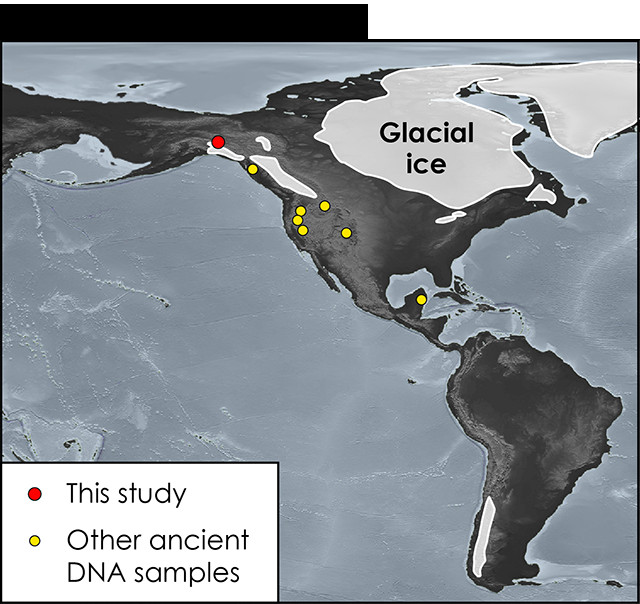
by Mary Caperton Morton Wednesday, March 16, 2016

The Late Pleistocene remains of two infants recovered from the Upper Sun River campsite in eastern Alaska are shedding light on the peopling of the Americas. Credit: K. Cantner, AGI, after Tackney, et al. 2015.
About 11,500 years ago, two infants were laid to rest side by side in a shallow grave 80 kilometers southeast of what is now Fairbanks, Alaska. The area was once part of Beringia, a strip of ice-free land connected to Asia during the last ice age. Researchers found the remains in 2013, and have now sequenced the complete mitochondrial genomes of the two children. The results revealed that the infants had different mothers and that their genetic signatures are found today throughout North and South America.
Anthropologists have long suspected that the Americas were populated by nomadic people from Asia who migrated over the Bering land bridge during the last ice age, when sea levels were much lower. Glacial evidence suggests that this land bridge was open between 28,000 and 18,000 years ago. However, the oldest evidence of people in the Americas dates to about 15,000 years ago, leaving researchers to wonder what took these nomads so long to move south from Beringia after crossing the land bridge.
The newly published mitochondrial DNA sequences — the oldest sequences recovered to date this far north — lend support to an idea called the Beringian standstill hypothesis. The hypothesis suggests that after the first Americans migrated across the Bering land bridge from Asia, they spent up to 10,000 years in Beringia before moving south into the Americas, possibly because ice blocked the route.
The DNA results are helping answer some long-standing questions about the Beringians, says Justin Tackney, an anthropologist at the University of Utah and lead author of the new study, published in Proceedings of the National Academy of Sciences. “These remains are the closest we’ve gotten yet to figuring out who lived in Beringia,” he says. “Did they have genetic signatures that look like Asians? Or Native Americans?”
Because the remains were found far north in a cold environment, they were well preserved, enabling the team at the University of Utah’s Ancient DNA Laboratory to extract and sequence the complete mitochondrial genomes of both infants. The initial findings revealed that the children — a 6- to 12-week-old baby and a preterm 30-week fetus — had different mothers, raising questions about social structures and burial practices among the Beringians. The researchers also found that the two lineages represented by the children are still present today throughout North and South America.
“These lineages aren’t Asian; they’re distinctly North American,” Tackney says. That means that the population to which the children belonged had already been genetically isolated from Asian populations for enough time to differentiate into a unique genotype. “The most likely geographical place for this isolation to occur was in Beringia,” Tackney says, as it was surrounded by ice and water on three sides.
The findings help constrain when the first North American genomes likely evolved, says Ripan Malhi, a geneticist at the University of Illinois at Urbana-Champaign who was not involved in the new study. They don’t “tell us exactly where or when these mitogenomes evolved,” he says, but “we can now say with certainty that these two mitochondrial genomes were present by 11,500 years ago.”
The competing theory to the standstill hypothesis suggests that Native American lineages evolved only after people moved south, not while they were still in Beringia, Tackney says. But finding North American lineages in the infants only a few thousand years after the migration south began indicates those lineages were already present before the migration started.
The next step will be to sequence the nuclear genomes of the two infants, Malhi says. Sequencing nuclear DNA is more time-consuming and much more expensive than sequencing mitochondrial DNA, Malhi says, but whereas “mitochondrial DNA only tells us about the maternal line, nuclear DNA can trace all of an individual’s ancestral lines, giving us a complete picture of relatedness between both ancient and living individuals.” Sequencing the nuclear DNA may reveal whether the two infants shared the same father or were otherwise related, and could shed more light on their relationship to modern Native Americans, he says.
“This kind of sequencing has revolutionized our understanding of how people came to populate the Americas, but we’re still very much at the very beginning stages of realizing its potential,” Malhi says. “As we sequence more genomes of ancient individuals, the picture of the peopling of the Americas is going to become clearer and clearer.”
© 2008-2021. All rights reserved. Any copying, redistribution or retransmission of any of the contents of this service without the expressed written permission of the American Geosciences Institute is expressly prohibited. Click here for all copyright requests.